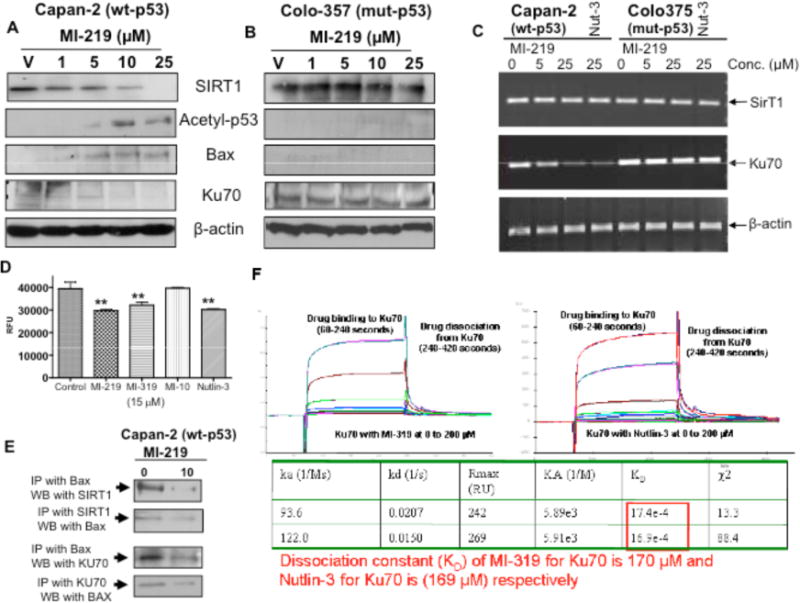Fig. (5). MI-219 suppresses SIRT1 and disrupts SIRT1-Bax as well as Ku70-Bax interaction in Capan-2 cells.

(A & B) Western blot analysis of lysates extracted from Capan-2 and Colo-357 cells exposed to increasing doses of MI-219 (0–25 μM for 24 hrs). Equal amount of protein was loaded and Western blot analysis was performed using anti-SIRT1, anti Ku70, anti-Bax and anti-acetyl-p53 antibodies. Anti-β-actin antibody was used as protein loading control as shown for each blot. (D) SIRT1 FRET based screening assay for activity of MDM2 inhibitors against SIRT1. Assay was performed in 96 well plate according to manufacturers protocol. Note suppression of SIRT1 post 15 μM MI-219; MI-319 or Nutlin-3 treatment. No suppression in SIRT1 by MI-10. (E) (Left Panel) Co-immunoprecipitation of MI-219 treated Capan-2 cell lysate was performed with SIRT1 followed by Western blot analysis with Bax and vice versa. Note reduced association of SIRT1-Bax interaction in drug treated cells. (Right Panel) Co-immunoprecipitation of MI-219 treated Capan-2 cell lysate was performed with Ku70 followed by Western blot analysis with Bax and vice versa. Note reduced association of Ku70-Bax interaction in drug treated cells. Blots are representative of three independent experiments. (F) Label-Free analysis of binding using surface plasmon resonance (SPR) reveals that both MI-319 and Nutlin-3 bind to Ku70 protein with low to mid micro-molar dissociation constants (KD). 8000 refractive index units (RU) of recombinant KU70 were covalently immobilized on the surface of Fc4 on a gold CM5 SPR chip, and refractive index changes were monitored in real time after injection of concentration series of MI-319 at 25 °C. Binding was permitted over 300 seconds followed by wash with HBS-EP for 480 seconds to reveal dissociation. Sensogram were normalized to a common baseline, and fitted using BIAevaluation software to estimate drug ON-rates (Ka) and Drug OFF-rates (Kd) followed by calculation of KD (ka/Kd).
